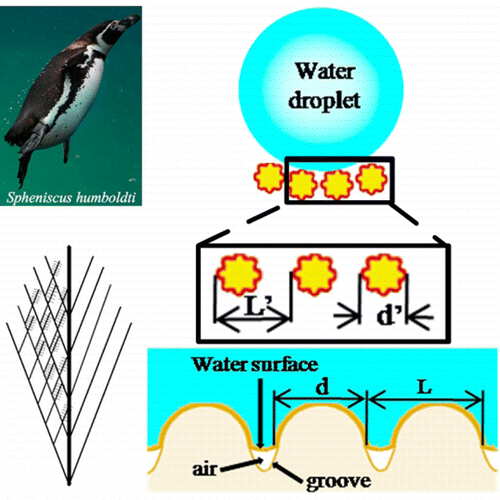What makes penguin feathers ice-proof

Humboldt penguins live in places that dip below freezing in the winter, and despite getting wet, their feathers stay sleek and free of ice. Scientists have now figured out what could make that possible. They report in ACS' Journal of Physical Chemistry C that the key is in the microstructure of penguins' feathers. Based on their findings, the scientists replicated the architecture in a nanofiber membrane that could be developed into an ice-proof material.
The range of Humboldt penguins extends from coastal Peru to the tip of southern Chile. Some of these areas can get frigid, and the water the birds swim in is part of a cold ocean current that sweeps up the coast from the Antarctic. Their feathers keep them both warm and ice-free. Scientists had suspected that penguin feathers' ability to easily repel water explained why ice doesn't accumulate on them: Water would slide off before freezing. But research has found that under high humidity or ultra-low temperatures, ice can stick to even superhydrophobic surfaces. So Jingming Wang and colleagues sought another explanation.
The researchers closely examined Humboldt penguin feathers using a scanning electron microscope. They found that the feathers were comprised of a network of barbs, wrinkled barbules and tiny interlocking hooks. In addition to being hydrophobic, this hierarchical architecture with grooved structures is anti-adhesive. Testing showed ice wouldn't stick to it. Mimicking the feathers' microstructure, the researchers developed an icephobic polyimide fiber membrane. They say it could potentially be used in applications such as electrical insulation.
More information: Shuying Wang et al. Icephobicity of Penguins and an Artificial Replica of Penguin Feather with Air-Infused Hierarchical Rough Structures , The Journal of Physical Chemistry C (2016). DOI: 10.1021/acs.jpcc.5b12298
Abstract
Although penguins live in the world's coldest environment, frost and ice are seldom found on their feathers. That is to say, their feathers exhibit excellent antifrosting or anti-icing properties. We found that their air-infused microscale and nanoscale hierarchical rough structures endow the body feathers of penguins Spheniscus humboldti with hydrophobicity (water CA ≈ 147°) and antiadhesion characteristics (water adhesive force ≈ 23.4 μN), even for supercooled water microdroplets. A polyimide nanofiber membrane with novel microstructures was prepared on an asymmetric electrode by electrospinning, acting as an artificial replica of a penguin's body feather. The unique microstructure of the polyimide nanofiber membrane results in a density gradient of the surface chemical substance, which is crucial to the formation of gradient changes of the contact angle and adhesive force. With decrease of the density of the surface chemical substance (i.e., with increase of the distance between adjacent fibers), the static water contact angles decreased from ∼154° to ∼105° and the water adhesion forces increased from 37 to 102 μN. Polyimide nanofibers pin a few supercooled water microdroplets. By increasing the distance of adjacent polyimide fibers, coalescence between the pinned water microdroplets was prevented. The polyimide fiber membrane achieved icephobicity.
Journal information: Journal of Physical Chemistry C
Provided by American Chemical Society



















